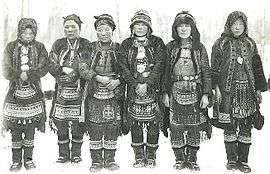Evens
| эвэсэл · эвены | |
|---|---|
 | |
| Total population | |
| 22,487[1][2] | |
| Regions with significant populations | |
| 22,383[1] | |
| 104[3] | |
| Languages | |
| Russian, Even | |
| Religion | |
| Shamanism, Russian Orthodoxy | |
| Related ethnic groups | |
| other Tungusic peoples | |
The Evens /əˈvɛn/ (эвэн; pl. эвэсэл, evesel, in Even and эвены, evëny in Russian; formerly called Lamuts) are a people in Siberia and the Russian Far East. They live in some of the regions of the Magadan Oblast and Kamchatka Krai and northern parts of Sakha east of the Lena River. According to the 2002 census, there were 19,071 Evens in Russia. According to the 2010 census, there were 22,383 Evens in Russia. They speak their own language called Even language, one of the Tungusic languages. The Evens are close to the Evenks by their origins and culture. Officially, they were considered to be of Orthodox faith since the 19th century, but the Evens managed to preserve different forms of non-Christian beliefs, such as shamanism. Traditional Even life is centred upon nomadic pastoralism of domesticated reindeer, supplemented with hunting, fishing and animal-trapping. There were 104 Evens in Ukraine, 19 of whom speaking Even. (Ukr. Cen. 2001)
The ancestors of the Evens were believed to have migrated from the Transbaikal area to the coastal areas of eastern Siberia. The Ewen herders also rode their reindeer. The economy was supplemented by winter hunts to obtain wild game. Hunters sometimes rode reindeer, sometimes moved along on wooden skis.
In the 17th century, the people today known as the Eveni were divided into three main tribes: the Okhotsk reindeer Tungus (Lamut), the Tiugesir, Memel’ and Buiaksir clans as well as a sedentary group of Arman’ speakers. Today, they are all known as Eveni.[4]
The traditional lodgings of the Evens were conical tents which were covered with animal skins. In the southern coastal areas, fish skins were used. Settled Evens used a type of earth and log dugout. Sheds were erected near the dwellings in order to house stocks of frozen fish and meat.
The Soviet years marked significant changes for the Evens. The Soviets created a written language for them and got rid of illiteracy among the Evens in the 1930s. Many nomadic Evens chose to settle down, joined the kolkhozes and engaged themselves in cattle-breeding and agriculture.
Famous Evens
- Viktor Lebedev, freestyle wrestler
References
- 1 2 Ethnic groups in Russia, 2010 census, Rosstat. Retrieved 15 February 2012 (in Russian)
- ↑ "About number and composition population of Ukraine by data All-Ukrainian census of the population 2001". Ukraine Census 2001. State Statistics Committee of Ukraine. Archived from the original on 17 December 2011. Retrieved 17 January 2012.
- ↑ "About number and composition population of Ukraine by data All-Ukrainian census of the population 2001". Ukraine Census 2001. State Statistics Committee of Ukraine. Archived from the original on 17 December 2011. Retrieved 17 January 2012.
- ↑ B. O. Dolgikh and Chester S. Chard (trans.), “The Formation of the Modern Peoples of the Soviet North" Arctic Anthropology 9(1) (1972): 17-26
Further reading
- James Forsyth, "A History of the Peoples of Siberia",1992
- Vitebsky, Piers (2005). Reindeer People: Living with Animals and Spirits in Siberia. HarperCollins. ISBN 0-00-713362-6.